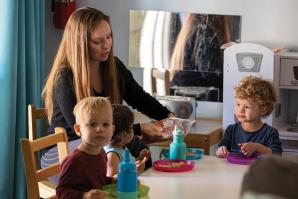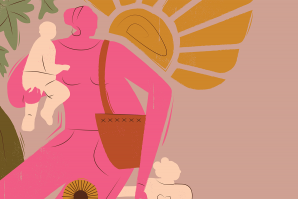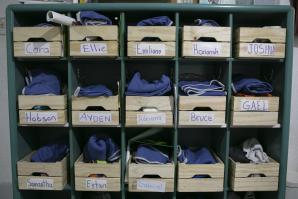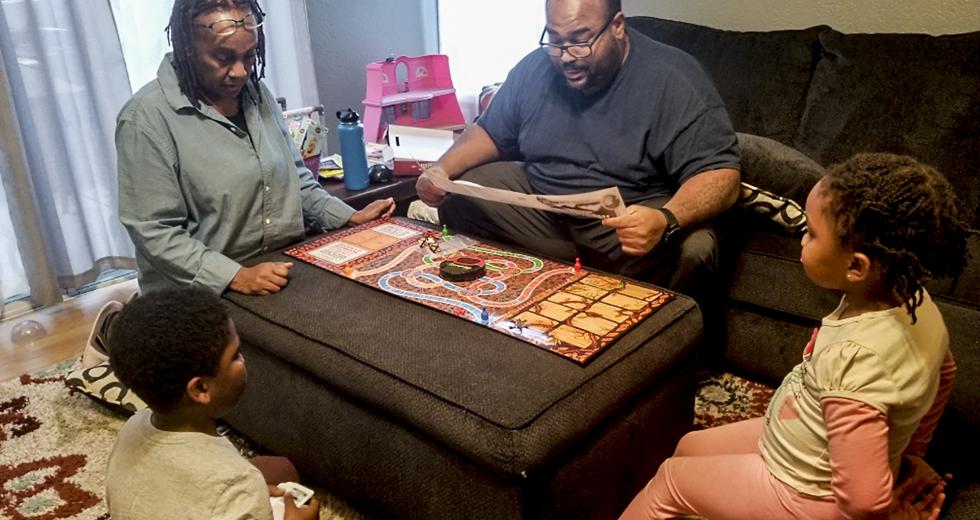Californians struggling to juggle going to work at hospitals, fire stations and grocery stores while worrying about child care are the intended beneficiaries of a new executive order signed by Gov. Gavin Newsom.
Amid the COVID-19 pandemic, the order will allow state agencies to waive regulations, offer state-subsidized child care and placement priority to parents deemed essential workers, and allow some after-school child care options to be open during what used to be regular school hours.
Click here for more coronavirus coverage
“This is a matter of paying for it or matching up child care with essential workers who need it,” said Kim Kruckel, executive director of the Child Care Law Center in Berkeley. “What the governor’s order does is make it possible for our state agencies to use federal and state child care money to pay for the child care of the children of essential workers.”
Essential workers are responsible for hundreds of thousands of children in California. Health care workers alone have more than 305,000 children under the age of 12, according to an analysis using U.S. Census data done by researchers from Yale University and Colorado State University. And all those children require care.
Kruckel said she thinks there are enough licensed child care operators to meet the need without waiting for new pop-up centers. There are 10,770 licensed child care centers and 25,940 licensed family child care homes in California, according to statistics from Kids Data, a clearinghouse of child health information in Palo Alto.
It’s unclear if child care for these critical workers will be entirely free — but this opens a pathway for many to qualify for help, Kruckel said. To be financially eligible for state-subsidized child care in California, a household can’t exceed 85% of the state’s median income, or about $70,000 for a family of three, she said.
Under the order, the state departments of Education and Social Services must release specific guidance by Tuesday. Social Services oversees all licensing for child care centers and family day care sites.
The state will allow agencies to waive administrative and other rules — cutting paperwork for example — for child care programs, and funding tied to eligibility that might prohibit some families from enrolling.
One thing that won’t change: the pre-existing priority for children who have been abused or neglected.
Newsom’s executive order aims to provide clarity for child care providers who’ve asked the state for help figuring out whether to stay open, if they can prioritize the kids of essential workers, and if they can expand their licenses intended for younger kids to also take in school-aged children.
State agencies now say they’ll provide detailed guidance to child care providers about how to limit the number of children grouped together under their care, keep meals and snacks safe, screen the health of staff and children, and ensure the kids practice physical distancing.
“The Executive Order aims to give health care workers and other critical infrastructure workers peace of mind, knowing child care services are considered part of the essential infrastructure and programs are available,” emailed Scott Murray, spokesman for the Social Services Department. “Most importantly, this will reduce disruption to California’s children, who will continue to have access to child care and development opportunities, with stable and consistent routines to minimize and reduce stress in uncertain times when children and families are enduring life changing adverse experiences.”
Whether school districts will use the executive order to provide child care is unknown. Los Angeles Unified School District had planned to open 40 child care centers when it first announced the closure of regular school, but the district quickly canceled that plan, instead opening “grab and go” sites to distribute food. District leaders have said they changed direction under the advisement of public health officials. District spokeswoman Barbara Jones said in an email Sunday that the district had no response yet to the governor’s order.
Health care and other essential workers have been scrambling for child care since schools shut down several weeks ago and many child care and preschool centers closed their doors. Some parents who have to care for coronavirus patients or who are driving ambulances or delivering food have left their kids with extended family members or relied on a partner now working from home, among other stopgap measures. If those options aren’t available, some may also be taking time away from work if they have no other options, experts said.
“Obviously having resources that haven’t been an option to our nurses and other health care workers is always helpful, especially when nurses work odd hours and late nights,” said Stephanie Roberson, spokeswoman for the California Nurses Association. She said ensuring flexibility is vital because nurses often work varying shifts and can be called in on a moment’s notice.
For health care workers, this could be a great relief, said Joshua Martin, a licensed vocational nurse working in a Kaiser hospital. He and his wife Stacy McCall-Martin, a mental health therapist, are both essential workers. They struggled to arrange child care options for their two kids the first two weeks school was out.
First, they traded taking days off. Then they tried finding a sitter or nanny but discovered that was going to be too expensive. Finally, McCall-Martin’s mother ended up watching the children, although Joshua and Stacy worry about her health because she is over 60.
Martin said the help from the state is welcome, but he would still be very careful about selecting a center to care for his children.
“It would take away from having to spend the money, and my mother-in-law would be safer. It would be a blessing,” he said. “It’s very stressful wondering about the children and worrying about how long this is going to go on.”
Steve Trossman, spokesman for SEIU-United Health Care Workers, which represents 97,000 hospital workers across the state including Martin, said members are waiting for the details of the order.
“We are glad to see the governor taking action on a problem that has created high levels of stress and anxiety among health care workers and other essential employees, who in too many cases are being asked to choose between taking care of people with COVID-19 and making sure their kids are safe,” Trossman said.
Last week the union released the results of a survey of 565 workers across the state that showed 80% of the health care workers said child care is one of their top challenges and undermining their ability to work, along with senior care. Eight in 10 of the respondents said they have kids younger than 14 at home and 63% said they are “scrambling” to find child care daily.
Other states have faced similar challenges and suspended certain regulations like zoning requirements in order to ease the burden. Here, the city of San Francisco has opened child care centers for essential workers in libraries and recreation centers.
“It’s incredibly important for child care to be opened up for essential health care workers,” said Walter Gilliam, a professor of child psychiatry and psychology at the Child Study Center at the Yale School of Medicine. “We need to make sure that our health care providers who are going to work worried about how to protect themselves are not additionally saddled with the burden of who is taking care of their children.”
Gilliam said he applauds Newsom’s order, but said any efforts to do this still need to ensure the safety of children and staff.
“If you don’t do this right, you won’t be doing it long,” Gilliam said.
He also warned that the state also needs to have a Plan B ready when teachers and other child care workers get sick.
CalMatters.org is a nonprofit, nonpartisan media venture explaining California policies and politics.
–
Stay up to date on the effects of the coronavirus on people and business in the Capital Region: Subscribe to the Comstock’s newsletter today.
Recommended For You

Child Care Crisis
The region’s shortage is at critical levels, and part of the problem is not enough space. Capital Region leaders are looking for ways to get more facilities up and running.
As of 2017, Sacramento County had enough licensed child care slots to accommodate little more than a quarter of children with working parents. State and local officials are spearheading efforts to change that.

The Cost of Caring
For mothers affected by the soaring cost of child care, companies that offer help have an edge
Tonja Candelaria would probably be living in the Pacific Northwest, working at her dream job of public relations for a zoo, if she hadn’t chosen to have children.

As Coronavirus Upends California, Question Remains: Who’ll Watch the Kids?
As schools, businesses, governments and most other venues go increasingly dark in the effort to restrict the pandemic, one question has persisted: What to do about child care?

Help for Displaced Workers
What employers and employees need to know about job protection and wage replacement during the COVID-19 pandemic
In the COVID-19 pandemic, business as usual has been upended and employers and employees are facing uncharted territory. Comstock’s spoke with Roseville-based employment law attorney Drew Lewis about what job protection and wage replacement programs are available in the Capital Region.



